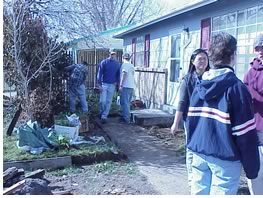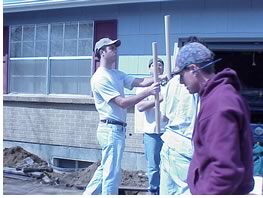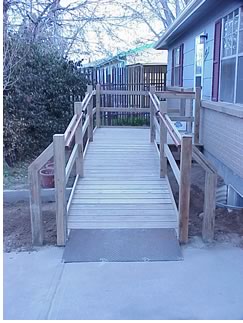
Architects find simple, low-cost ways to remove barriers from housing units

Associate Editor
For many residents in the Colorado area, little improvements really do make striking differences in their homes. For example, minor changes might help a person access the second floor of the house, walk without imminent fear of falling, or simply pass through the front door unassisted. Most important among these enhancements are safety considerations. Running a close second, they are quality of life issues.
There is now a concerted effort to address these concerns and help identify and remove barriers in the homes of individuals with disabilities. Freedom by Design, a program started last November in Denver, is working in about 25 homes in Colorado communities to improve the built environment of housing. The brainchild of Brad Buchanan, AIA, principal of Denver-based Buchanan Yonushewski Group, Freedom by Design seeks simple, low-cost alterations that "radically impact" the design of the home for its occupant, Buchanan said.
 Buchanan's
program helps people who are unable to qualify for other assistance. It
combines the efforts of architects with health-care and housing agencies,
nonprofits that work with people with disabilities, and local legal resources.
The program also seeks to work with professionals with similar missions,
including general contractors, engineers, and design/builders.
Buchanan's
program helps people who are unable to qualify for other assistance. It
combines the efforts of architects with health-care and housing agencies,
nonprofits that work with people with disabilities, and local legal resources.
The program also seeks to work with professionals with similar missions,
including general contractors, engineers, and design/builders.
Finding solutions
Volunteers first assess the home to detect built obstacles that prevent
access. Then the architect works with the client to prioritize and design
solutions to eliminate these barriers. First priority will go to safety
issues. The second consideration will be quality of life issues. Often,
these areas overlap.
"Most of the barriers being discussed can be eliminated through simple, low-cost alterations," according to Freedom by Design planners. For example, Buchanan said, it may just involve placing grab bars along the walls, changing flooring materials, lowering wall cabinets, or building ramps. "These are simple modifications that can enable a person to live independently without constant assistance and greatly improve an individual's confidence and self-esteem."
 Dawn
Russell, a program participant from Littleton, Colo., had at least one
simple request. A wheelchair user, she wanted access through the front
door of her home. For nearly two years, an attendant has had to carry
her and her wheelchair through the front door. Once the renovations are
completed, she will be able to roll up to her front door and into her
home.
Dawn
Russell, a program participant from Littleton, Colo., had at least one
simple request. A wheelchair user, she wanted access through the front
door of her home. For nearly two years, an attendant has had to carry
her and her wheelchair through the front door. Once the renovations are
completed, she will be able to roll up to her front door and into her
home.
This will be Russell's first accessible home. A tight housing market and lack of available housing led her to this unit because she knew she could work with what she had.
"Nothing was built accessible to sell," Russell said. Now an architect with the Freedom by Design project is working to build a ramp to her front door. He is also making improvements in her bathroom. He will make it wider, install a roll-in shower, lower the cabinetry, and create accessible shelving.
"It's going to be like a playhouse," Russell said.
 Right
now, Freedom by Design provides the support structure for the program
and then encourages the architect to shepherd the project through the
design and building process. This may include raising funds for labor
and supplies, building partnerships that encourage donations, and, if
necessary, completing paperwork for permits.
Right
now, Freedom by Design provides the support structure for the program
and then encourages the architect to shepherd the project through the
design and building process. This may include raising funds for labor
and supplies, building partnerships that encourage donations, and, if
necessary, completing paperwork for permits.
Soon, Freedom by Design hopes that local chapters will provide more monetary resources and coordinate the donation of supplies so that architects can concentrate their efforts on the design build process, according to Leslie Acosta, another Freedom by Design organizer. Locally, Freedom by Design has representatives and donations from several architecture firms and industry groups such as AIA Colorado and AIA Denver, including AIA Denver's Design/Build and Housing Committees.
Kathy Parker is a graduate student at the University of Colorado at Denver. She and a team of classmates worked on the home of Sherita Green, who has juvenile arthritis and hidratinitis supertiva, a skin disease that causes boils and ulcers on her body.
Parker, the project manager for the Green's home, first talked with Green and her mother to assess the home and determine priorities. As a result, the team built a 13-inch rise from the driveway level to the front door, put handrails inside the house, and switched out the doors to accommodate a lever-style handle.
After determining what it wanted to do in the Green's
home, the team began raising the necessary funds of about $3,000. Most
of it came from private sources and through connections with people in
the group. Parker said they had a "great response" to their
call for help. They applied for and received a permit from the city, and
then completed all the labor themselves over two weekend days.
"Architects have the ability to make a safe and comfortable home
base for a person," Parker said. "A person like Sherita needs
a little extra help facing the world." She continued that it takes
very little effort to provide that comfort for people in the community.
"We were honored to be involved to help somebody in such a significant
way,"
Andy Lemmer, an architecture intern at Intergroup, participated in the program after learning about it at a business meeting in his office. Intergroup is donating his time as well as supplies for his project. Lemmer is helping to create a better environment for Allan Perry, whose illnesses include Down's Syndrome, a brain disorder, and seizures. He is also helping Perry's mother, who injured her back while caring for Perry and carrying him up and down the stairs.
Lemmer, whose background includes work as a handyman, worked to understand the needs of the family and emphasize their abilities rather than their disabilities. The improvements Lemmer has made have helped Allan build his strength, and are helping him learn to walk with greater independence.
Architects as community
leaders
Buchanan said the idea for this project "popped into his head"
one evening. He and his firm had participated in volunteer activities
before, but he wanted to create a program that would allow professionals
to make a longer-term commitment to a project and create something that
would be substantive and on-going.
"Through the AIA it is possible to perpetuate one of our goals—to have architects who are real leaders," who are able to make "quantitative and qualitative" contributions to their communities.
Architects are passionate about their communities, and are very interested in working in neighborhoods in transition. As a profession, "we like the fact that we get to make a difference in our neighborhood."
Buchanan also realized that architects can give a voice and provide resources to a constituency that often lacks both attributes. He believes there is a prejudice that makes it harder for people with disabilities to get things done.
Dawn Russell, the program participant agrees. "Everything has always been adaptive," Russell said. She says we have to see accessible homes as a good idea and as "something of value."
Russell also points out that she and her architect are working concurrently to make her house beautiful, too. "People think accessibility is not a pretty thing, but access can be a beautiful part of the home."
"We have to start thinking that this has to be done," Russell said.
Freedom by Design has set an aggressive goal for expanding the project nationwide, with satellite offices in 50 cities in 50 weeks. There are now five chapters in five cities, and Denver Mayor Wellington Webb has proclaimed June 30 as "Freedom by Design Day."
There will be a major work and publicity effort to celebrate that designation.
Copyright 2001 The American Institute of Architects. All rights reserved.
![]()
|
For more information, visit the Freedom by Design Web site or contact the office, 303-861-4600. |
|